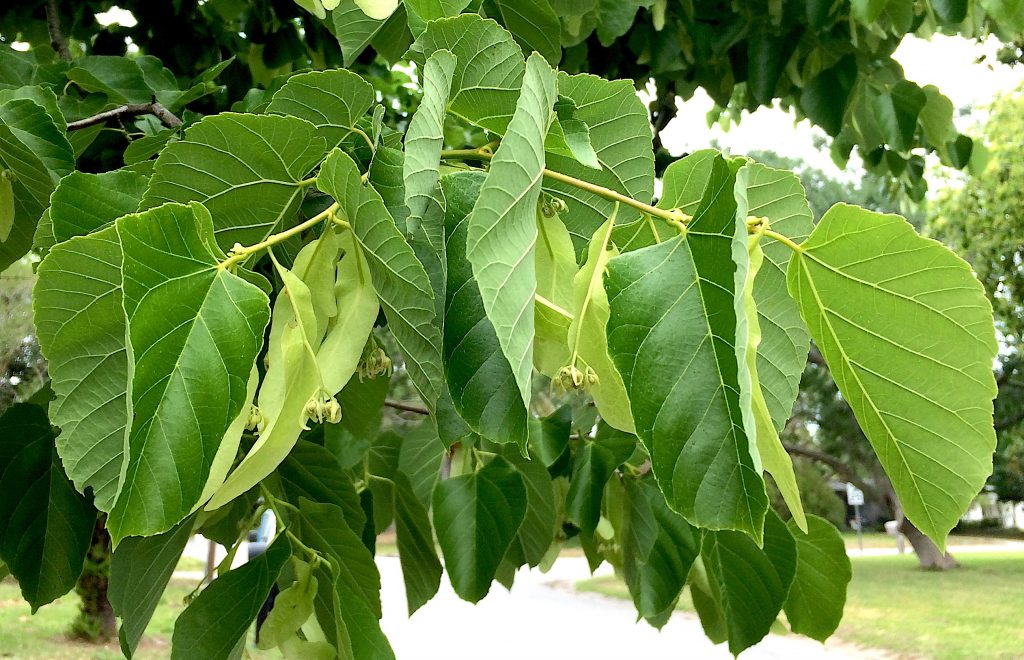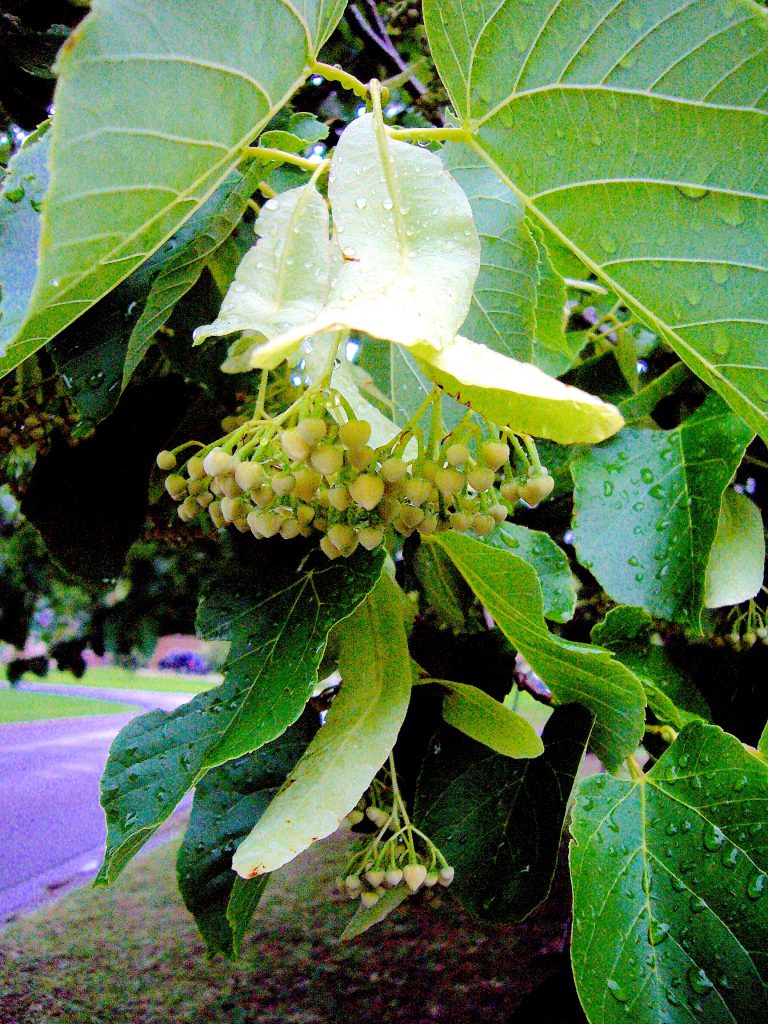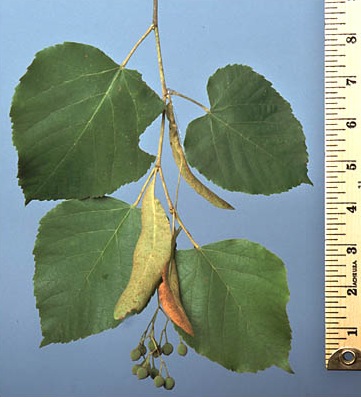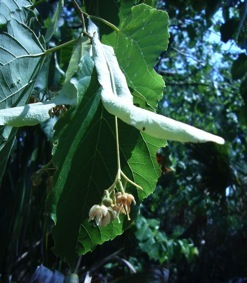
Tilia americana: Forest Fast Food
My first recollection of basswood was not on the supper table but rather helping my step-father make pipes.

First we’d find a nice piece of applewood for the bowl; take the bark off then boil the bowl wood for a couple of hours on (of all things) the wood stove. That “drove” the sap out so when it dried or was used it wouldn’t crack. After the bowl was shaped, sanded and drilled a stem was needed. That’s when we’d go find a basswood sapling of just the right size to make a stem. At that young age it’s easy to run a wire through the core and ream out the pith. That was fitted to the bowl and the pipe was done except for polishing. Dad would rub the sides of his nose with the finished bowl to give it a shine. Oil glands on our nose apparently are perfect for that. I still have one or two of those pipes we made from some 60 years ago.

It was not unusual that we turned to the Basswood for utilitarian uses rather than food. Even among the native Indians only one tribe — the Ojibwa — was known to eat parts of the Basswood. Others may have but there is no record of it. Indeed, modern foragers may actually consume more of the tree than the Natives did. However, the tree was a major source of fiber for the Indians and that’s where the common name, Basswood, comes from.“Bass” is a corruption of “bast” which is a type of fiber. The Indians soaked the bark for two to four weeks to loosen long fibers. They used the fibers for many of their needs: Bags, baskets, belts, fishnets, house mats, snowshoe netting, ropes, sewing thread and even suturing wounds. It was used where a lot of fiber strength was not needed. The Ojibwa ate the young buds raw or cooked as greens and they used the sweet sap, boiling it down to a syrup. Fortunately, there is more to be had.
Besides the buds the young leaves are a prime “wild green” of the forest. Young shiny shoots are also tasty. Edible raw or cooked you can make a salad using the leaves as the main ingredient like lettuce. Cooked they lose flavor and shrink in size considerably. The cambium, between the outer bark and the wood, in spring time, is moist and tastes of cucumber. It’s good for soups or when dried can be powdered and used for bread. You can also eat it raw off the tree, the least amount of work for the nutrition and flavor. However, don’t destroy the tree for it. Take vertical pieces.
While the flowers are edible raw or cooked and a tea can be made from them. Two tablespoons per cup. They also produce a lot of nectar creating high-quality honey. For that Basswood is sometimes called the “Bee Tree.” The tree also has a small nut, more like a seed. Fill one pocket with them as you wander through the woods, crack ’em with your teeth and spit out the shell. The tree can produce seeds when as young as eight years and continue to 100. Past 120 years old the tree starts to get a lot of “cavities” and becomes home to a many woodland creatures, notably porcupines and raccoons. Basswoods can live up to about 200 years old.
As you would guess, denizens of the forest like the Basswood as well. Whitetail deer, rabbits, mice, voles, squirrels, chipmunks and foxes snack on the tree, as do many species of song and game birds including quail. Some voles, however, girdle the tree, killing it.
One particular habit of the Basswood is to produce sprouts, especially after the main tree dies. Often you will find a clump of basswood sprouts of varying sizes, many of which get large enough to harvest. Basswood is valued for its wood which is soft, light and easily worked wood, particularly for turned items and hand carving. Natives made face masks out of it. Before synthetics it was was the material of choice for prosthetic limbs. It’s also been used to make boxes, toys, woodenware, drawing boards, veneer, venetian blinds, plywood and pulp. The Iroquois even used the bark as an emergency bandage for wounds.
One problem with the Basswood is what to call it. It has multiple common and scientific names. Experts can’t agree if there is one species with variations or several species, though they are all edible. While some call the Basswood that grows in Florida Tilia floridana (TILL-ee-uh flo-re-DANE-nah) the current name de jour is Tilia americana (a-mair-ee-KAY-na) . Tilia comes from the Greek word “ptilon” meaning wing, referring to the large winglike bracts of the flower cluster. Some think they look more like tongues than wings. Americana means of America and floridana of Florida. As for common names, particularly in Europe, the Basswood is called the Linden tree. That name comes from the Old English word of “linde.” It’s been called that for some 1300 years. So, where did “linde” come from? That’s a bit more … sticky.
Folks of yore somehow noticed that when a bird “deposits” a mistletoe seed the seed sticks to the tree. That is how mistletoe, a parasite, gets from tree to tree. So they used mistletoe (or holly) to make a glue to put on tree limbs to catch small birds. That was called birdlime, lime coming from the Latin word for mud, limus, so less poetically, bird mud. So limus became lime which became lime+en which became by 700 AD linde which then became linden. Many Brits today call the Basswood the lime tree. (The citrus “lime” came from the Arabic limah.) Lime, in the sense of mud, is still with us today. When we mark a field for sports it is called liming the field.
Personally, I like the young leaves right off the tree when they are about the size of your thumb nail. On one hike through Spring Hammock in Seminole County a Basswood tree had toppled over. Not uncommon in Florida. Weeks earlier it was upright. But this was prime leafing out season and though toppled it was putting on leaves and I ate my fill. Mild, slightly sweet, tender. Well worth looking for. And one more thing: A paste made from the seeds and flowers of the Basswood tree is a good substitute for chocolate.
Green Deane’s “Itemized” Plant Profile
IDENTIFICATION:
Tall tree to 100 feet, round uniform crown. Leaves alternating, distinctly heart shaped and strongly toothed. Creamy, five-petaled flowers in small clusters,. unique tongue-like light-colored bract with each flower cluster. No other tree in North America has such an arrangement. Gray bark, furrowed with flat ridges.
TIME OF YEAR:
Spring in Florida, early or mid summer farther north.
ENVIRONMENT:
Deep, well-drained soil. In Florida that is close to fresh water, lakes and streams
METHOD OF PREPARATION
Season new young leaves, smaller than mature leaves, lighter in color and shiny. Raw or cooked. Young shiny shoots, raw or cooked. The buds raw or cooked, a bit mucilaginous. Cambium raw or cooked, seeds raw or cooked though usually eaten raw on the trail. Sap boiled down to sugar.




Does anyone have a picture or a means to identify a linden tree seedling that has sprouted with two main leaves? I have a tree in the back yard and tons of sprouts…but I cant tell if they are from an elm tree or the linden. Please Help.
About a year later than you asked; I just started noticing these trees a few days ago. I asked at a nearby nursery and they said it looked like a Basswood/Linden. I did some looking online and the characteristics were just like my trees. If it still helps, I took a couple of pictures, but I’m just realizing that I can’t see any link for attaching them to this message. If you do want the pix, contact me by e-mail and I’ll attach them to a reply message.
Bob
I would love to try to make the chocolate substitute. Have you attempted this yet? Do you peel the fruits or do you grind them with the hull on? Also, when do they cease to work as a chocolate substitute?
I find the European Linden Tree, Tilia cordata, also called small leaved linden, to have better tasting leaves and you can eat them all year round.
John S
PDX OR
I have basswood in my Minnesota yard. The spring leaf buds and tiny leaves are delicious. Once the leaves get more than two inches long they taste grassy, but as they get larger they become tasty again. I frequently step out the door, pick a hand-sized leaf, and put it in a sandwich instead of lettuce.
Can these Linden/Bass wood trees be found in Texas?
It is found in eastern and central parts of Texas.
I have used the dried flowers (Tilia cordata) as a tea and they have a lovely, delicate floral scent/taste. Can’t wait to try the leaves come next Spring – thank you!
Green Deane, you are my hero! I live in Florida and have given up on trying to do bushcraft here because I thought that Florida doesn’t have the classic trees in the north such as birch, basswood, hickory, poplars, etc. but are proving me wrong! thanks for all you do and it is just awesome to have someone in Florida that can tell me about nature in my backyard! by the way, what region of Florida are you in? central, northern, south?
I currently live in central Florida.
The tea made from linden flowers is so popular in Zurich that it is served in restaurants and sold in the grocery store. And the city sometimes smells strongly of lime tree in the Spring/Summer. Bees love this!
My neighbors have what I am sure is a basswood. He says that nothing will grow under it. Is there any scientific evidence that basswood does what (I think) chestnut and some maples do, which is excrete a toxin that prevents other things from growing underneath?
It isn’t that they exude any type of toxin, like walnuts do, but that the canopy is so dense on mature trees that sunlight cannot penetrate and rainfall only if it rains hard. I have a one in my yard, maybe about 50 years old, and nothing grows there. Nor under my similarly-aged sugar maples.
Linden name might derive from use for line/cordage the same as linseed and linen. I have made rope from basswood inner bark and then boiled in wood ashes it becomes silky and delightful to handle.
Here, N Minnesota there is one maybe more Basswood Lake. However the French/Voyageur name for the lake was Bois Blanc. Although bass wood is very light color what is more likely the bois blanc were paper birch trees which still grow in the area but I doubt basswood did.
I am doing research on my surname Lendale. I once read that it possibly means “People of the Linden Tree”.
My great great great grandmother changed our surname from Lanier (family slave name) to Lendale/Lyndale during a census round. She was supposedly Native American here in Florida. So she possibly knew all about the tree.
This was helpful in knowing about the Linden tree.
Thanks for writing. It is interesting how often language has significant for research that often seems removed from language. It’s an important aspect of botany, and of course genealogy. If you do enough genealogy you know spellings can be rather loose and family stories are almost always wrong but do contain a shadow of truth. Thanks for sharing.
They planted avenues of lime trees round here 80 years or so ago. They are now magnificent, with very tasty shoots through most of the summer. Nearly got my head kicked in last year for eating them though. Two young men approached, calling me a weirdo, swearing and being very threatening. As far as they were concerned, I was fair game. You have to be so careful in some places.
This is a ridiculous and sad reality
Can you make chocolate from both small leaved and standard american version of linden? Very curious! Any advice is helpful, thank you kindly, gina
If I remember correctly it is the seeds not the leaves that one uses for their chocolate flavor.
Hello and happy new year from Central Florida as well! Im on this seed/nut milk trend and I’ve been searching for a foraged alternative, particularly one I can find around these parts. Would this seed be a potential tester?
Yes, and Blue Beech.
What a great site! Where I live in Washington DC right now the linden trees are bloom. I always know because when I take my daily bike ride, i’m bowled over once again by the amazing scent. What else do you know about the lime tree and where can I find and in depth scientific or herbalist sources on the uses of this tree. I found that it has a lot of anti-oxidants which may be cancer fighting. Thank you.
This is wonderful, thank you. I have just ordered 3 (because it’s the only way they were being sold) small linden trees… T. cordata I think… I’m planting them as part of a tonic tea, and wondered what I’d do with 3 potentially huge trees and growing them in the wrong part of the world… I can forage two and let the other grow to its full glory 🙂 I had no idea about the delicious foliage, only that it is edible. 🙂 Thank you 🙂
i live in zone 9 in california and would love to have a Linden tree or 2 but they are usually as only going to zone 7 so I am hoping to find someone in Florida who I can purchase seeds from… please help!
or exchange seeds with!
thank you for any help
chris